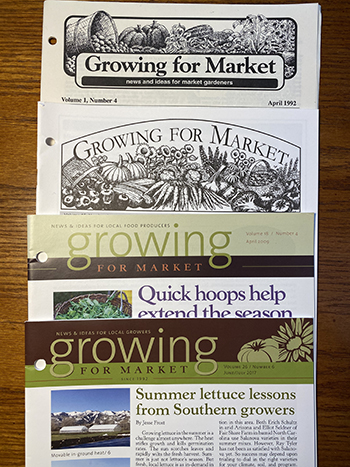The first issue of Growing for Market came out in January 1992, so this January marks the beginning of GFM’s 30th year. 2020 was a strange one to reflect upon; however unprecedented, it appears to have intensified the momentum building behind local food and flowers.
This past year was stressful, even for those of us whose businesses survived and even thrived through the pandemic. As Gretel Adams of Sunny Meadows Flower Farm puts it in her story in this magazine, having to make decisions, and then re-make them on a day-to-day basis as the pandemic unfolded, was exhausting.
Closer to home, my wife and GFM co-editor Ann’s nursery business, Seedlings by Annie, doubled gross income over the previous year. That was despite not being able to do the farmers market, which she’s always done. GFM saw a steady increase in subscribers over the course of 2020 as well. I feel extremely thankful to be healthy and in a business that actually grew through the pandemic. And it’s important to acknowledge the pain this year brought to everyone who lost health, loved ones and livelihoods.
This magazine is made to support people running farm businesses, many of which were started with hopes of improving human and planetary health; that’s our aim too. At a milestone like this, it’s important to assess how GFM is meeting that goal, and make sure we continue steering toward the future we want. We think it’s as important as ever to keep doing what we set out to do: to help local growers succeed by connecting them with news and ideas from each other.
I see the founding of GFM as a way to crowd source the best info from farmers, for other farmers, since before the term “crowd source” even existed. I have always felt we need to keep the magazine relentlessly practical, and focus tightly in on the growing, marketing, and business of running a local food and flower farm.
We are committed to continuing to publish a print edition, in fact in 2020 we ran our first few 32-page magazines ever (like this one!) allowing us to add late-breaking COVID coverage without bumping our regularly planned coverage. However, most months, even with 32 pages we have more ideas than we have space for in the magazine.
That’s why in 2021 we’re starting a podcast, and will continue to expand on social media and the website to keep serving GFM’s mission on and off the page. Stay tuned for more details when we’re ready to launch.

These are the four versions of GFM that have been published over the years, from black and white to color, always three-hole punched.
We don’t have the numbers yet, but my guess is that the growth of local food and flowers actually accelerated in 2020, due to shortages of some items in the grocery store, combined with negative publicity surrounding outbreaks in meat processing plants and other infrastructure of the industrial food system. The pandemic is making the cracks in industrial ag more visible to everyone, and is showing why we need local ag. I’m pretty sure that this year, people found it reassuring to know there was food growing in their (figurative or literal) backyards.
Though this momentum does give me hope for the future, I’m afraid we’re going to look back on the past 30 years as the time when we squandered our opportunity to change the course of global warming, as the disruptions caused by a changing climate become ever more destructive.
With that in mind, we embark upon the beginning of the fourth decade of Growing for Market with a renewed sense of purpose. Though local farming is gaining strength, we also need it more than ever, and the challenges are bigger than ever. For ourselves, for our children, and for our planet, let’s re-double our efforts to farm in a conscientious manner and be the fabric of our communities, and continue to be the change that we hope to see in the world. Here’s to our readers, and to continuing to make the world a better place through conscientious local agriculture.
I’d like to thank GFM Founder Lynn Byczynski, both for starting the publication from which I learned so much, and for the opportunity to take it over from her. One of the reasons I wanted to take it over is because I want someone who cares about GFM to steward into the future. She could have sold it to a magazine company, but by letting it become a part of our farm business, she ensured that GFM would remain an independent voice for promoting local agriculture. Read Lynn’s brief history of GFM on page 12.
And thank you to all of our subscribers; you’re the reason why we’re here. As a small publication, your subscriptions are what keeps us in business.
With kind regards and hope for a better year in 2021,
-GFM editor Andrew Mefferd
